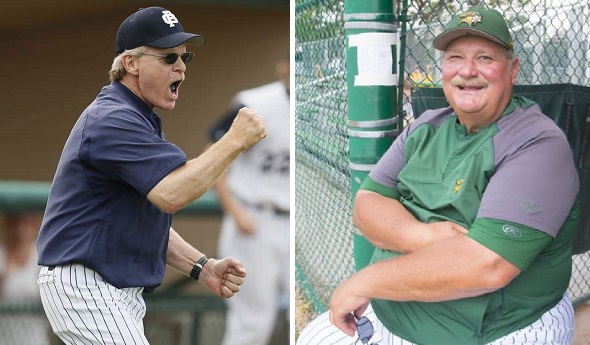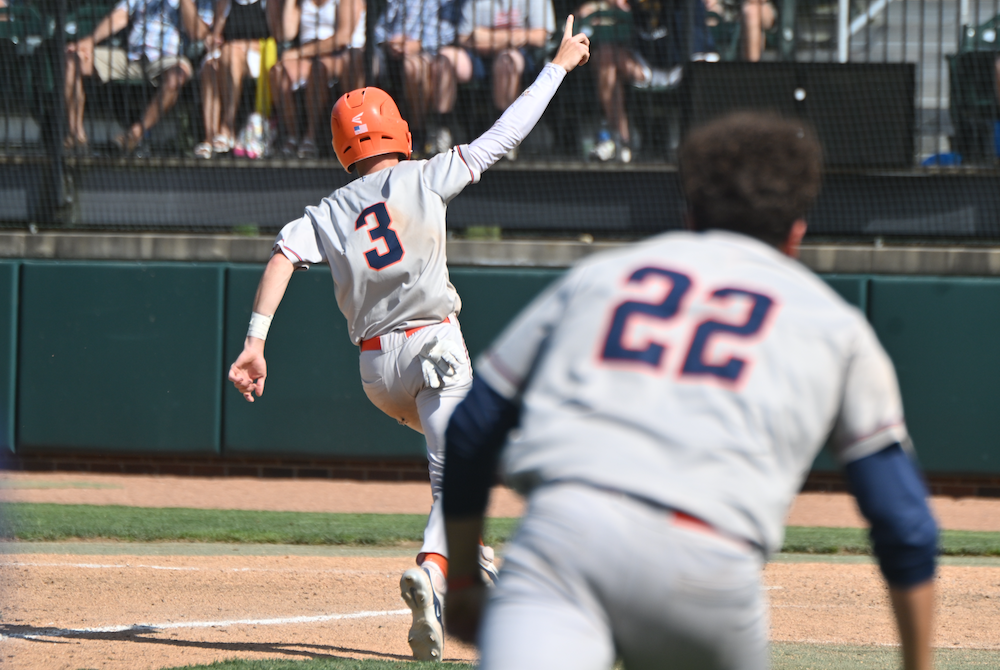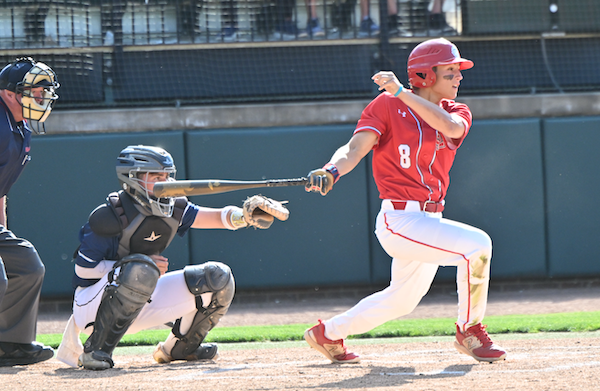
Pointes' Pride Instilled by Longtime Leaders
By
Tom Markowski
Special for Second Half
May 31, 2017
GROSSE POINTE – Neither Frank Sumbera nor Dan Griesbaum were raised in Grosse Pointe.
 But no one, at least at the high school level, has done more to enhance and promote baseball in the Pointes than this long-serving pair.
But no one, at least at the high school level, has done more to enhance and promote baseball in the Pointes than this long-serving pair.
Sumbera, 69, is in his 45th season as coach at Grosse Pointe North and Griesbaum, 64, is in his 34th season at Grosse Pointe South. In this sport the rivalry that exists between Grosse Pointe’s two public high schools is as good as it gets. Sumbera holds the upper hand in MHSAA Finals titles, 2-1, and Griesbaum has the edge in District titles, 23-14.
This last statistic is notable in a sense that the two programs are often paired in the same District, as they are this season. South will host North in a Division 1 District Semifinal at 10 a.m. Saturday.
This season there is an added twist to the much-anticipated community showdown. Grosse Pointe Woods University Liggett, for the first time, will compete in the Division 1 tournament lined up on the other side of the bracket from North and South. University Liggett will play Detroit East English in the other Semifinal at 11:30 a.m. The winners will play for the title approximately 2 p.m.
University Liggett won four MHSAA Finals titles the past six seasons, two in Division 4 and two in Division 3, including last season in the latter. Coach Dan Cimini, knowing he had a strong team returning, petitioned the MHSAA to opt up to Division 1 for this season and 2018.
So far the Knights have proven they can hang at the Division 1 level. They are ranked No. 2 in the latest poll released by the Michigan High School Baseball Coaches Association.
And Cimini’s group received a break in the draw as it won’t have to defeat both North and South to win the District title.
This is Cimini’s 14th season as head coach, and he tips his hat to the job Sumbera and Griesbaum have done in laying the groundwork.
“Frank has been there forever,” Cimini said. “Dan has been there a long time. I feel old, and I’m 48. I’ve coached 22 years. No doubt about it, those guys have set the standard.”
Cimini grew up in Grosse Pointe and competed in the city’s strong Little League program. He played for Griesbaum at South and played four years in college, two at Macomb College and two at University of Detroit Mercy. He was part of the 1987 South team that reached the MHSAA Semifinals for the first time in school history.
Cimini said the quality of baseball has remained strong in the community over the years but noted there have been some changes.
“The Little Leagues are phenomenal,” he said. “The Federation ball is phenomenal. But there aren’t as many kids playing. Now there are seven teams playing in the (Little League) majors. Back when I played there were 13 of 14. I miss those days. If I could take myself back, that’s where I’d go.”
At least in the modern era, one must point to Sumbera as the person most responsible for the quality of baseball being played at the high school level.
Sumbera played three sports at Chesaning High – baseball, basketball and football – and then went on to Central Michigan where he played basketball.
 Upon graduation Sumbera went looking for a job and received a tip from a college roommate. Sumbera was told that Grosse Pointe High would be splitting into two schools, North and South, and that they needed teachers, and, naturally, coaches. North opened for the 1968-69 school year, and Sumbera was hired as an assistant junior varsity football coach. In 1973 he became the assistant varsity baseball coach, and the next season he took over the baseball program.
Upon graduation Sumbera went looking for a job and received a tip from a college roommate. Sumbera was told that Grosse Pointe High would be splitting into two schools, North and South, and that they needed teachers, and, naturally, coaches. North opened for the 1968-69 school year, and Sumbera was hired as an assistant junior varsity football coach. In 1973 he became the assistant varsity baseball coach, and the next season he took over the baseball program.
“We won the District that year,” he said. “I’ll never forget it. We beat (then Detroit, now Warren) DeLaSalle, 2-1, in the final.”
Sumbera has coached some of the best teams in the state. His 2006 Division 1 championship team was 38-1. His 1980 Class A championship team was probably his best. Five players on that team were selected in the Major League Baseball amateur draft including Bill Babcock, one of the top pitchers on that team. Babcock’s son, Luke, will enter the ninth grade next fall is expected to enroll at North and play for Sumbera.
That’s the way it is in the Pointes. This large community that borders Detroit’s eastside is infectious. It’s common for someone who grew up here to remain in the area and raise his or her own family.
“A lot of the kids I coached in the 80s, I’m coaching their sons,” Sumbera said. “They play a lot of baseball here. As they grow through the ranks to high school, (Griesbaum) and I have to make cuts. You might have 250 at the Little League level, and by the time I get them we have like eight.
“The North-South rivalry is as good as any around. I coach football, and it’s intense every year. In baseball it’s as good a rivalry as there is in the state. It’ll be the fifth time we will have played South (this season). In our last doubleheader we won the first, 12-6, and lost the second, 3-2, in eight innings. That was a crusher. It’s big. The kids know it. The families know it. They all go to church together and play against each other during the summer.”
Griesbaum, a graduate of St. Clair Shores South Lake and Central Michigan, where he played baseball, said the level of competition is remarkable especially when one considers the schools do not have open enrollment. The only way one can play for North or South is to live in the school district.
Griesbaum got his start as an assistant under Sumbera (1980-83) before going to South in 1984.
“There’s nothing like a North-South game,” he said. “Our rivalry is one of the best. It’s a baseball community. My 6-year-old grandson plays T-ball. You look at what North and South have accomplished. There’s the (Grosse Pointe) Farms and City (Little League) teams. Then there’s the success of the Redbirds that (former Detroit Tiger) Dave Bergman ran. We run a (Christmas) Holiday hitting camp. We have 75 kids the first day and 75 more the next. It’s for the second through the sixth grades. We want to expose baseball at an early age.”
Some have expressed displeasure that all three Grosse Pointe schools are in the same district. Cimini scoffs at that thought. He said there are many districts throughout the state that have more than their share of quality teams.
The last two seasons North and South were in separate Districts, and they won their respective Districts both years. In 2015, they met in a Division 1 Quarterfinal, and South won. It was the Blue Devils’ seventh trip to the Semifinals, a record (tied with Saline and Grand Ledge) for a public school in Division 1/Class A.
Cimini said he’s looking forward to seeing what his team can do against the established powers.
“I can’t wait,” Sumbera said. “The whole thing is, come June 3 you have to be ready to play.”
 Tom Markowski is a columnist and directs website coverage for the State Champs! Sports Network. He previously covered primarily high school sports for the The Detroit News from 1984-2014, focusing on the Detroit area and contributing to statewide coverage of football and basketball. Contact him at [email protected] with story ideas for Oakland, Macomb and Wayne counties.
Tom Markowski is a columnist and directs website coverage for the State Champs! Sports Network. He previously covered primarily high school sports for the The Detroit News from 1984-2014, focusing on the Detroit area and contributing to statewide coverage of football and basketball. Contact him at [email protected] with story ideas for Oakland, Macomb and Wayne counties.
PHOTOS: (Top) Grosse Pointe South's Dan Griesbaum, left, and North's Frank Sumbera both have led their respective programs for more than three decades (Sumbera for more than four). (Middle) University Liggett coach Dan Cimini played for Griesbaum at South and has built a top program in the community as well. (Photos courtesy of the Griesbaum family, C&G Newspapers and the University Liggett baseball program.

Flint Powers Catholic, Spring Lake End Long Waits to Reach Season Finale
By
Scott DeCamp
Special for MHSAA.com
June 14, 2024
EAST LANSING – After his eighth-inning, game-winning hit to finish Flint Powers Catholic’s Division 2 Semifinal win Friday, Chargers senior Gavin Darling gave away the secret to how 42-year head coach Tom Dutkowski stays so young and energetic.
“That dude works out more than probably half the team, honestly,” Darling said. “He’s a great guy, and we just want to do it for him as well.”
What top-ranked Flint Powers is aiming to do is capture a state baseball championship. Powers has that chance after Darling’s walk-off single to deep left field scored Eli Sturgess for a 4-3 victory over Trenton at Michigan State University’s McLane Stadium.
Powers (36-6) will face Spring Lake (32-9) in Saturday’s 5 p.m. Final. The Chargers are seeking their first Finals title since 1980, and first under Dutkowski’s tutelage.
“We want to win for him, man. It’s not only for us, but it’s for him,” Darling said. “He’s been working hard just like we have.”
Powers and pitcher Grant Garman cruised through the first four innings Friday, Garman carrying a perfect game as the Chargers built a 3-0 lead.
Trenton (30-11-1) began to make Powers work for it in the fifth. The Trojans collected five hits and scored three runs in the inning, keyed by Carson Boike’s two-run single, to knot the score at 3.
The tie remained until the bottom of the eighth inning, when Darling came to the plate with one out and the bases loaded. Powers’ cleanup hitter saw a pitch he could drive, and the rest is history.
“Just (looking for) a pitch to hit, man. They were playing in, so I just had to go for it. I don’t care if it’s a bloop single or a shot like that, I’ve just got to do what I’ve got to do,” Darling said. “(It felt) pretty good to know that I had a guy on third that either way, if it’s caught, he’s tagging and we win the game.
“It’s an unreal feeling, man. These guys are my family, and I can’t thank them enough. They have my back just like I have theirs, and I can’t thank them enough.”
Garman allowed three earned runs on six hits with 10 strikeouts and one walk in five innings. Isaac Sturgess picked up the win in relief, not allowing a hit or run with four strikeouts and one walk over three innings.
Garman led the Powers offense with three hits, while Darling had a pair of RBIs.
Caleb Kidd finished with two hits to pace Trenton. Kidd got the start and worked four innings, allowing three earned runs on five hits with five strikeouts and three walks in four innings. Joel Mator took the loss in relief for the Trojans, surrendering one earned run on three hits with five strikeouts and five walks in 3 1/3 innings.
“I can’t say enough about the fight that was in them,” Trenton coach Todd Szalka said. “He had a shutout (perfect game), we’re going into the top of the fifth, he’s throwing a no-hitter, and then, all of a sudden, we challenge them in the dugout and we come away with five hits in the fifth inning. I mean, that’s almost unheard of, especially against a good pitcher like (Grant) Garman.
“No. 1 team in the state, you’re down 3-0, stakes are on the line, you’re looking at your last nine outs and our kids just continued to fight and went into extra innings. They got the big play when they needed it, and we had gotten the big play the last three games with walk-offs. I’m really proud of the way we came out today.”
Dutkowski instructed Darling to be “short to the ball” on his game-winning hit. The coach was very happy for the player, who “works as hard as anybody.”
Dutkowski believes his team is plenty battle-tested, too, competing in the Saginaw Valley League.
“The Saginaw Valley League is a gauntlet, especially for a school like Powers (as) the smallest school,” he said. “Not that we feel bad about that because we’ve got great players this year, but it is tough.
“ … We beat Bay City Western two out of three this year, and we beat Northville in the Flint Champions Tournament. Neither team was pitching their best, but we beat them. Yeah, we’re battle-tested.”
Dutkowski said that in his younger years, he might have been jumping up and down in the third-base coach’s box during the walk-off play.
On Friday, he said he stayed planted and wanted to make sure Eli Sturgess was tagging at third in case Darling’s deep fly ball was caught.
“I used to be what you’d call an athlete. I used to do all the histrionics, but now my job is to kind of keep guys steady, you know – get them back to neutral as soon as possible,” Dutkowski said.
“I have an ankle-foot orthotic. I am drop foot. I had fusion surgery about 19 months ago on L-4/L-5. No, I’m a wreck. I have this carbon fiber thing,” he said as he pointed to his lower right leg, “that keeps me upright. I’m retired now, so I work out.”
Spring Lake 5, Richland Gull Lake 2
“Next pitch” has been a theme for the Spring Lake baseball team during its run to the Finals.
Of course, when you have Zane Stahl throwing the pitches, that always helps.
The 6-foot-6 Louisville commit scattered five hits and pitched to contact in powering Spring Lake to a 5-2 victory.
On Saturday, Spring Lake will be making its first Finals appearance since 1995 and third overall. The Lakers got there Friday in large part because of Stahl, the defense behind him, and timely hitting.
 Stahl, a right-handed junior, struck out four, walked four, and allowed two earned runs in the complete-game effort.
Stahl, a right-handed junior, struck out four, walked four, and allowed two earned runs in the complete-game effort.
“(The defense) has been incredible. I’ve been able to make my pitch,” Stahl said. “You know, it’s not always about strikeouts; it’s about making the pitch and getting a ground ball. I mean, they’ve been able to make the routine plays that they’re supposed to and even make them outside of that, so it’s been great.”
Stahl helped his own cause, too. He finished 2-for-3 at the plate with two RBIs. Oliver Smies doubled twice for Spring Lake, while Gabe Trask had two hits for the Lakers, who have won 19 of their last 20 games.
Spring Lake took a 1-0 lead in the first inning and created separation with four runs in the fifth inning on four hits.
“Somebody else always seemed to pick us up at the right time. We got a couple of nice ground-ball double plays, so some things have fallen into place for us but I’m also a believer, sometimes you make your own luck,” Spring Lake coach Bill Core said. “What we’ve been impressed with so much is somebody always seems to pick up their teammate or somebody’s been coming through with a big play at the right time.
“We’re not a bunch of superstars, but everybody has a role and we’ve got a different hero (each game).”
Gull Lake (26-12) showed life in the later innings, scoring a run on two hits in the sixth and another run on two more hits in the seventh.
Western Michigan University commit Julian Harris took the pitching loss for the Blue Devils. The right-hander allowed three runs (two earned) on five hits with eight strikeouts and one walk in four innings.
“When you get to the final four, no one’s weak, especially against a good arm like (Stahl’s) – you’re scratching and clawing for every run that you get,” Gull Lake coach Reggie Walters said. “If you tie that ballgame up, it just changes the feel of things instead of chasing.
“We wanted to wear (Stahl) down and he started to show that in the sixth and the seventh, but he threw a great game. … It was like, ‘Man, if we would have started it one inning earlier, you don’t know where you’re going to end up.’”
PHOTOS (Top) Flint Powers Catholic's Eli Sturgess (3) crosses the plate for the winning run during his team's Semifinal victory Friday at McLane Stadium. (Middle) Spring Lake’s Gabe Trask drives a pitch.

